By Yanmin
This article is the first of a series of lectures on Alibaba Cloud robotic process automation (RPA). It describes the basic concept of RPA, the value RPA creates for enterprises, and the advantages and disadvantage of RPA.
After the first decade of the 21st century, most enterprises around the world are facing two severe challenges. The first challenge is the soaring labor costs, which lead to increasing operation costs. The second challenge is that the internal processes of enterprises are becoming increasingly complicated due to rapid business development, while increases in work efficiency lag behind business development. Therefore, with the rapid development of information technology, global entrepreneurs need to think about and resolve these two pressing issues: how to use effective technical means to reduce enterprises' labor costs and how to continuously increase business processes automation and the work efficiency of employees. This was the context in which RPA arose.
RPA is a new technical concept that allows software robots to simulate and execute established business processes through rule-based interactive actions. Like human beings, RPA robots can use a variety of IT applications, such as browsers, Office software, programs developed using Java or .NET Framework, and ERP software (SAP/Oracle). RPA robots interact with other systems based on specified rules and are good at executing boring and tedious repetitive tasks. RPA robots perform better than human beings because they can run 24 hours a day, 7 days a week without making mistakes (except in the case of a system breakdown or power failure) or receiving any salary (much cheaper than ordinary employees). Therefore, RPA robots have proved extremely popular among all major enterprises around the world since their emergence.
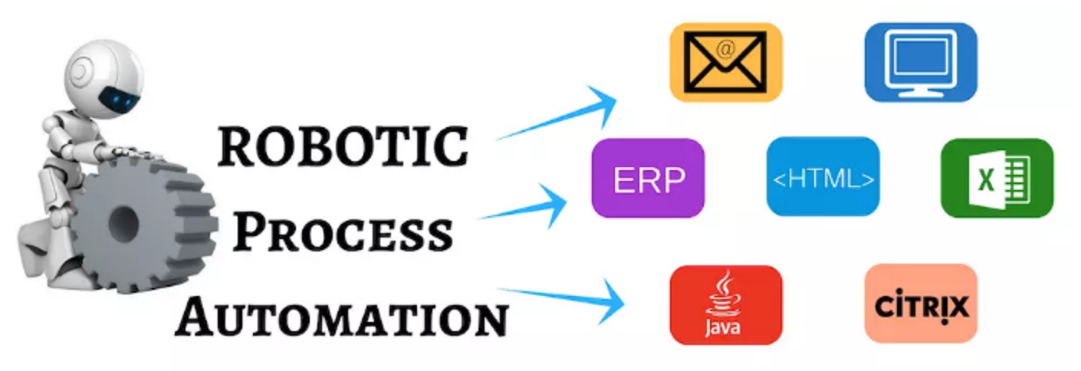
If a new technology or concept cannot create true values for enterprises and improve their productivity, the technology or concept will be inevitably phased out. RPA not only helps reduce the labor costs of enterprises, but also continuously improves the efficiency of business processes and employees through automated technical measures. It has become an important aspect of technological innovation in the enterprise service field both in China and abroad. The following describes the RPA functions and reasons why enterprises need RPA.
(1) Integrate isolated information
As enterprise services become increasingly diversified and business processes become more complicated, many information islands are formed within enterprises. RPA can help integrate service flows and connect upstream and downstream business processes through automated techniques, forming small-scale business loops. In addition, RPA robots can transmit data between separate information systems and build a set of information tunnels based on data transfer, greatly improving the efficiency of business lines.
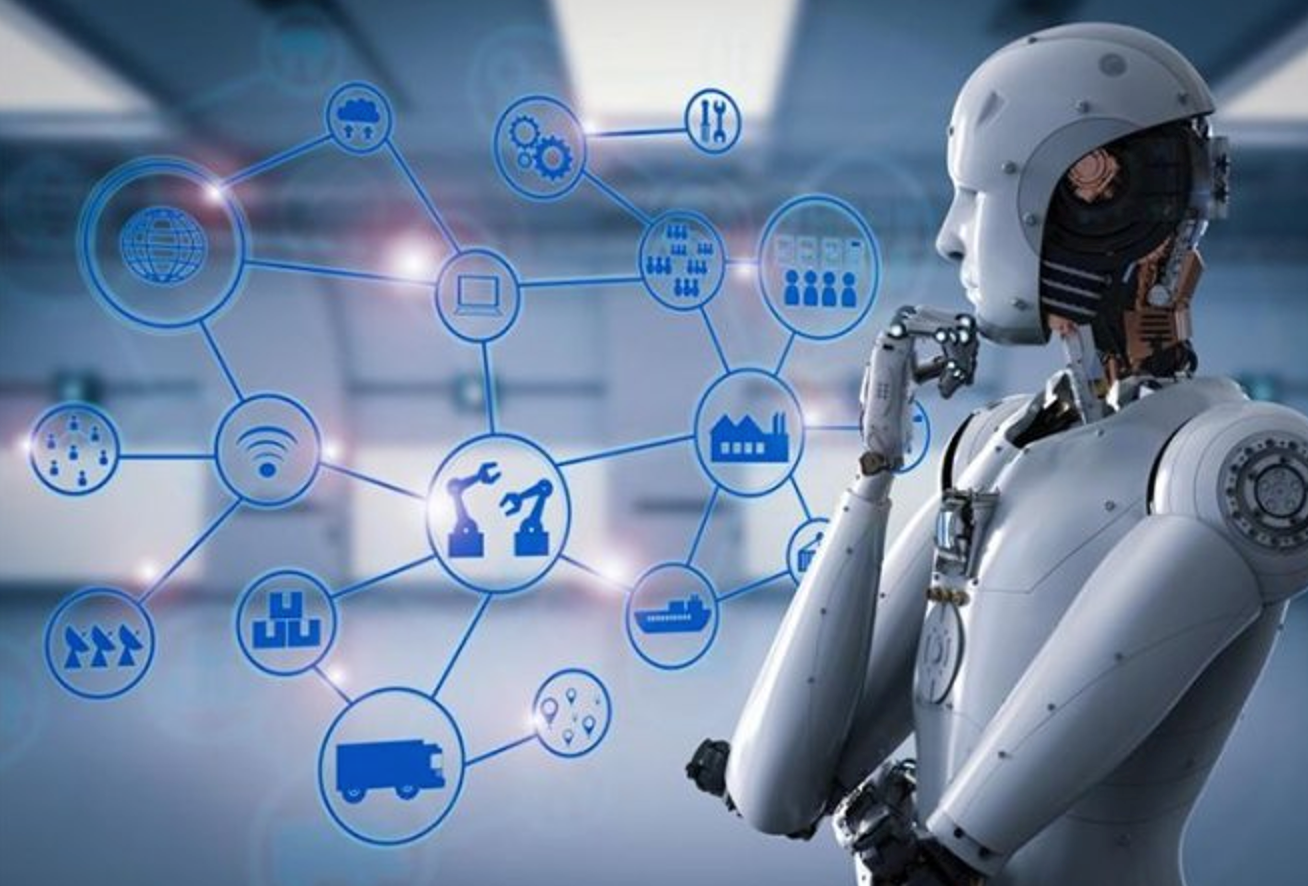
(2) Greatly reduce enterprise labor costs
According to the China Enterprise Social Insurance White Paper 2018, 53% of interviewed enterprises said that their labor costs accounted for over 30% of their total costs, and 16.27% of interviewed enterprises said that labor costs accounted for over 50% of their total costs. The surveys conducted over the past few years indicate that "high costs" have always been the biggest operational challenge for enterprises. The introduction of RPA can greatly reduce enterprises' manpower input. Based on our many years of experience, an RPA robot costs about RMB 50,000 (approximately USD 7425) per year on average, whereas a normal employee costs at least RMB 100,000 (approximately USD 14850) (including the salary and social insurance expenditures) or even more in tier-1 and tier-2 cities. Therefore, an RPA robot is at least 50% cheaper than a common employee. RPA robots can greatly reduce enterprises' labor costs. The greater use an enterprise makes of RPA robots, the more it can reduce its marginal costs.
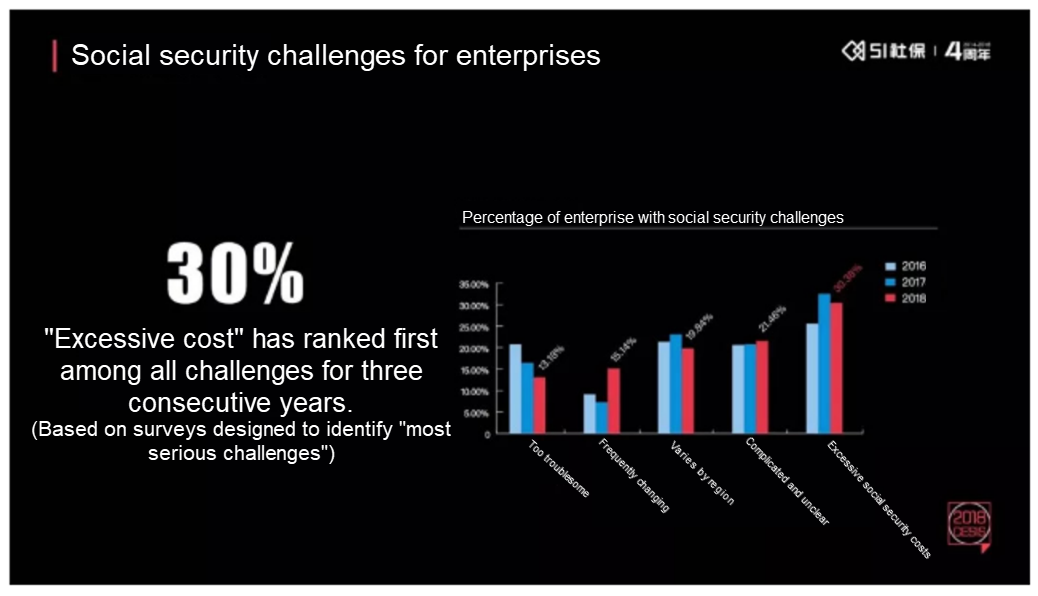
(3) Improve business process efficiency
Many enterprises are improving the efficiency of their business processes using business process management (BPM) tools or by means of process reengineering and optimization. However, due to reasons such as service complexity and cross-department operation, these solutions cannot be applied throughout the entire enterprise. For example, although BPM tools can simplify the processes to a certain extent and eliminate the waiting time and downtime between process steps, the major parts of processes are still completed manually. As for process reengineering and optimization, the existing processes need to be significantly modified at a high cost. Therefore, enterprises often choose not to redesign the processes or at least do not completely abandon their current practices. In contrast, RPA allows the separate business departments of an enterprise to customize their solutions and quickly build digital processes, which creates significant and sustainable value in a short period of time and greatly reduces the overall risks. RPA-based solutions can be developed and deployed by department. In this way, managers can quickly execute repetitive and tedious business processes, improving efficiency, reducing costs, and ensuring system flexibility.
The operation efficiency of human employees is sometimes low due to factors such as fatigue, external interference, and mood. However, RPA robots can generally run established processes two or three times faster than human beings. Besides, RPA robots can work 24/7 without making any mistakes. RPA robots can imitate most human operations, such as logging on to applications, moving files and folders, copying and pasting data, filling in forms, extracting structured and semi-structured data from documents, and capturing and running browser controls.
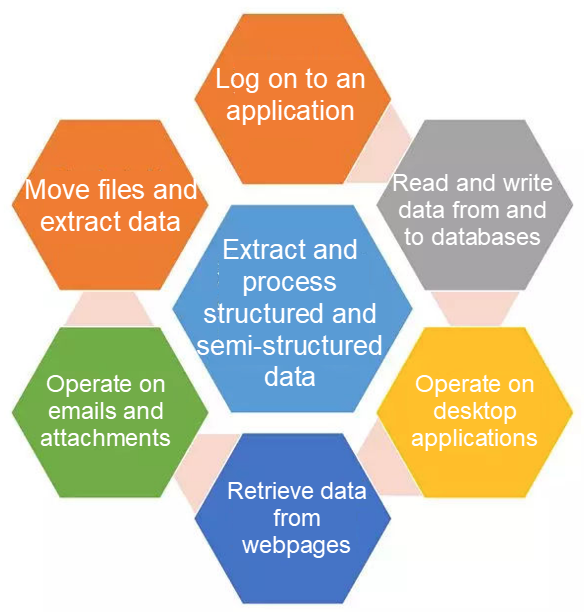
(4) No impact on the functions and stability of existing IT systems (non-intrusive)
RPA runs at a higher software level than ERP, OA, CRM, and other traditional IT systems. RPA does not intrude into existing software systems. Instead, it operates the systems at the presentation layer. In this way, while improving the enterprise efficiency, RPA can retain the stability and reliability of existing IT systems.
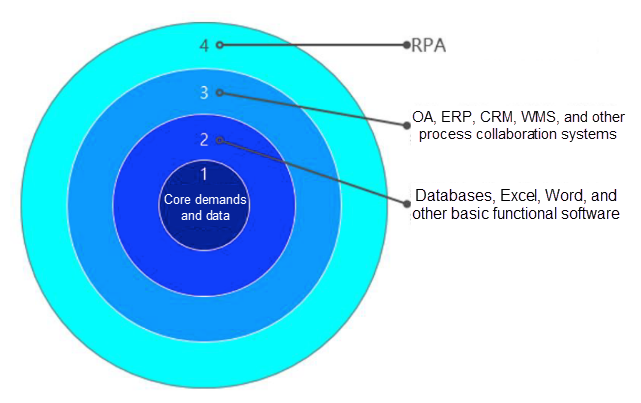
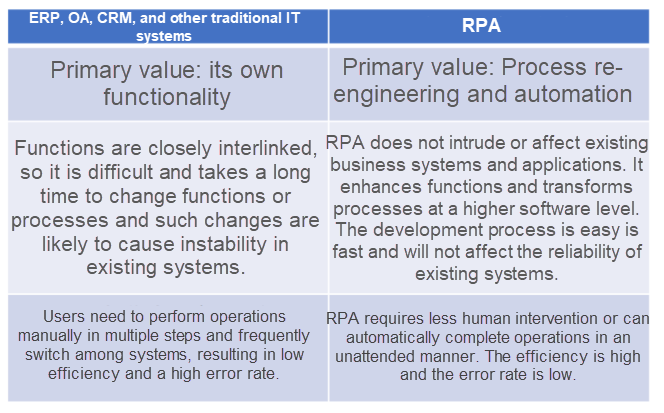
(5) Balances the development cycle and costs and shortens the ROI cycle
To increase efficiency, enterprises generally increase manpower or use traditional software development methods. Now, RPA robots provide enterprises with a third option with significant advantages. An RPA robot delivers a higher efficiency and a lower error rate as compared with human beings, and requires a smaller investment and shorter development cycle as compared with the traditional software development methods. Besides, the ease-of-deployment and enhanced development efficiency greatly reduce the costs and shorten the ROI cycle for enterprises. So far, most cost optimization and efficiency improvement solutions are implemented through the centralization and standardization of processes. RPA robots have natural advantages in running standard processes.
In conclusion, RPA robots play an important role in enterprises' digital transformations and business efficiency improvement. Through the rapid implementation and delivery of RPA projects, RPA robots promote the automation of enterprises' business processes, continuously create value for enterprises, relieve employees of repetitive and tedious work, and enable employees to focus on tasks where their skills can be more fully used, including data analysis, decision-making, and innovation. In this way, RPA can make enterprises more competitive and benefit all parties involved.
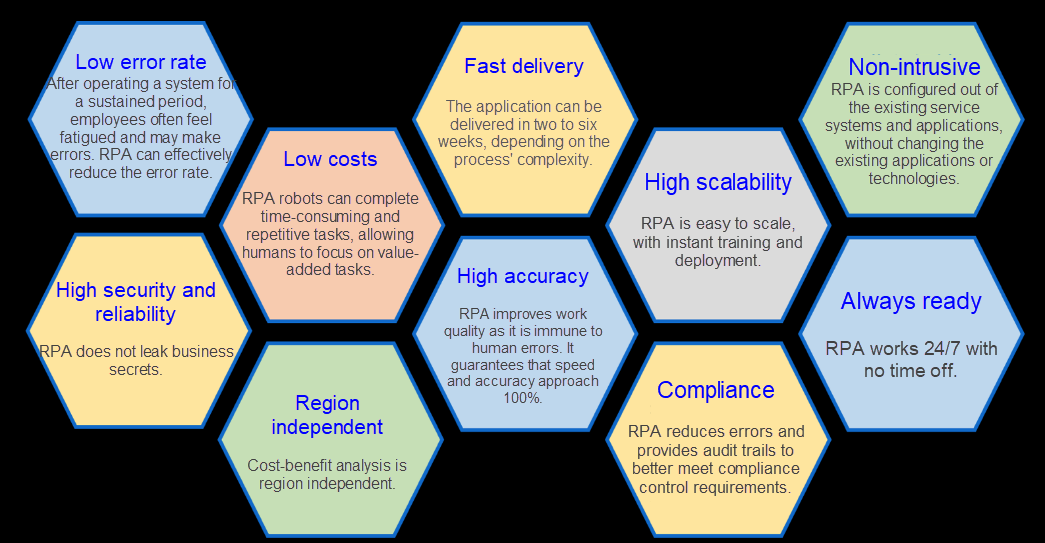
Advantages:
RPA robots operate on the system presentation layer, which does not pose any threat to or affect the stability of enterprises' existing systems. Based on the data security and integrity requirements of existing systems, RPA robots simulate human operations to access the current system and thus can coexist with the existing system without mutual interference.
In the RPA implementation and delivery process, there is little need to write code. RPA is designed to automate processes for enterprise service personnel who are familiar with business processes but have little programming experience. It helps service personnel learn to use RPA software in a short time and automate the orchestration of business processes using drag-and-drop operations based on encapsulated RPA software. Many Chinese and foreign RPA software provides graphical user interfaces (GUIs) similar to the flowchart designer. You only need to use icons representing steps in the process to create business process definitions.
Apart from server deployment and environment installation (taking about half a day), it generally takes only two to three days for a person familiar with the business processes to develop and launch a moderately complicate RPA application. This not only greatly improves the process efficiency but also removes service shortcomings. In addition, you can conveniently modify and maintain the application later. If the service is developed in a traditional mode (for example, Java or C#), the development cycle increases several times over.
RPA has many advantages, which cannot all be discussed in this lecture. By using RPA in actual business scenarios, you can understand the benefits of RPA to the daily work of enterprises and employees.
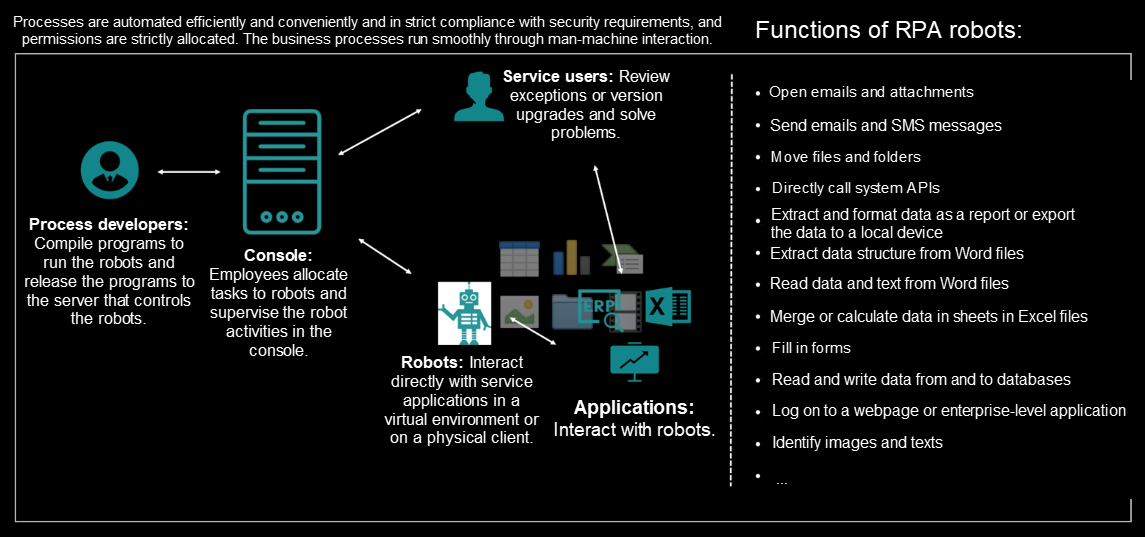
Disadvantages
RPA operates quickly and efficiently but must be based on clear rules and processes. If any rule is incorrect or constantly changes, RPA robots may make mistakes. If a business process requires complex and fuzzy judgment logic, robots cannot make all decisions and human intervention is required. In this case, RPA technology is not applicable.
At present, no Chinese or foreign RPA vendor can provide a perfect mechanism for exception handling during application operation and they have failed to provide good solutions for problems such as downtime, process rollback, and the resumption of interrupted processes. In some processes that have special requirements, the Imperfect exception handling mechanism may result in a poor experience for enterprises or even cause unnecessary economic losses.
However, RPA is not just a technology, but an indispensable part of digital transformation. By integrating AI and big data technologies, RPA has created a new intelligent labor force. This shows us a glimpse of the future of work.
yanmin - June 27, 2019
yanmin - June 27, 2019
yanmin - June 27, 2019
yanmin - June 27, 2019
Rupal_Click2Cloud - November 15, 2023
Sally - October 29, 2019
 Robotic Process Automation (RPA)
Robotic Process Automation (RPA)
Robotic Process Automation (RPA) allows you to automate repetitive tasks and integrate business rules and decisions into processes.
Learn More Auto Scaling
Auto Scaling
Auto Scaling automatically adjusts computing resources based on your business cycle
Learn More Offline Visual Intelligence Software Packages
Offline Visual Intelligence Software Packages
Offline SDKs for visual production, such as image segmentation, video segmentation, and character recognition, based on deep learning technologies developed by Alibaba Cloud.
Learn More Network Intelligence Service
Network Intelligence Service
Self-service network O&M service that features network status visualization and intelligent diagnostics capabilities
Learn More